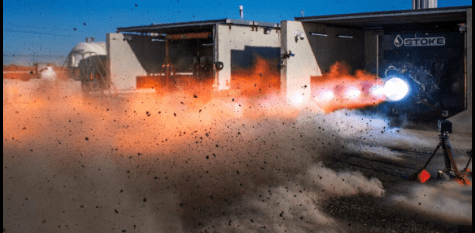Stoke Space is doubling down on bold innovation, pushing the boundaries of reusable rocket technology to solve the one challenge that truly transforms space launches: making full, rapid reusability practical and affordable.

In an industry where small improvements barely make a dent, Stoke Space is taking a “go big or go home” strategy—targeting the core problem that could drastically reduce launch costs and revolutionize access to space. Their approach focuses on engineering breakthroughs, faster turnaround times, and simplified reuse systems so rockets can return, refuel, and fly again quickly.
This high-risk, high-reward path could reshape the future of commercial spaceflight. If Stoke Space succeeds, it won’t just be about beating competitors—it will redefine how humanity reaches orbit.
Launch Complex 14: The Long Road to Building a Modern Launch Site
Building a launch site isn’t fast — and Stoke Space learned that firsthand.
Back in 2020, founders Lapsa and Feldman were busy designing the rocket that would later become Nova and figuring out if the business could truly scale. By December, they raised $9.1 million in seed funding, which pushed one major priority to the top of the list: finding the right place to launch.
Cape Canaveral quickly stood out. It’s the heart of America’s launch industry, filled with suppliers, customers, and experienced talent. Even better, in 2021 the US Space Force announced it would lease the historic Launch Complex 14—the same pad where John Glenn launched into orbit in 1962. Retired in 1967, the site had since become a National Historic Landmark.
Stoke Space won the lease in 2022, but that was just the beginning. Before construction could start, they had to complete an extensive Environmental Assessment, which took almost two years. Only on October 20, 2024, were they finally cleared to break ground.
Because nothing on the site was usable—except the iconic Mercury-era blockhouse—everything had to be torn down, cleared, and rebuilt from scratch.
Now, as they walk the massive ring of their future launch base, the progress is real:
✔️ A new launch tower
✔️ A fully installed launch mount
✔️ Tanks and major ground systems on site
✔️ A nearly finished building for rocket assembly and payload processing
Stoke Space is deep into the most technical phase—integrating systems, wiring infrastructure, and preparing for Nova’s future liftoffs.
The Engineer Who Transformed Stoke Space’s Launch Site Vision
As Stoke Space worked through the final stretch of its environmental approvals, the company gained a major asset: Jonathan Lund, a tall, lean engineer with a signature thick beard and an impressive résumé. A Stanford graduate who began his career with the US Army Corps of Engineers, Lund spent years at SpaceX during the late 2010s. There, he helped rebuild a launch pad, led work on the crew tower at Launch Complex 39A, contributed to a pad at Vandenberg, and even worked on several Falcon 9 landing sites.
By the time he arrived at Stoke Space, this was already his fifth launch pad project — and every site brings new challenges. Florida’s biggest one? The water table sits just a few feet below the surface, making deep construction tricky. But rockets like Nova need a significant trench to safely redirect engine exhaust during ignition. As we stood inside the massive flame diverter, a few thin streams of groundwater seeped through, reminding us of the constant battle with Florida’s soil.
Despite that, Stoke recently cleared a huge milestone: testing its water suppression system. This system protects the launch pad by flooding the area with water at liftoff. As the rocket engines fire, the exhaust hits the water, instantly turning it into steam. That thick layer of steam acts like a protective cushion — reducing energy, noise, and stress on the launch mount.
The Countdown to Nova Begins
With the launch pad steadily coming together, the next big question is: How close is the Nova rocket itself?
So far, Stoke Space seems to be taking all the right steps. Earlier this year, the company shipped a full-scale second stage to its Moses Lake test facility in central Washington. There, the stage went through qualification testing — repeated cryogenic fuel loading, pressurization cycles, and structural checks. According to Lapsa, everything performed as expected.
The team also built a shortened version of the first stage, with full-sized tanks and domes but not full height. That test article also completed and passed qualification testing.
Now, Stoke Space is officially building flight hardware for the first Nova rocket. Software systems are improving quickly, and the company is making strong progress on its automated flight termination system — a crucial safety requirement. “Having a team that’s been through this cycle many times, it’s something we started focusing on early,” Lapsa explained. “It’s on a good path as well.”
Still, the most intense phase is yet to come. The months before a debut launch are always chaotic: assembling the full rocket for the first time, conducting the first full-system firing, discovering issues, and fixing them under pressure. Something will go wrong — the only unknown is how serious those problems will be.
Lapsa, as always, refuses to predict an exact launch date. And honestly, that’s wise. Anyone in the space industry knows timelines for brand-new rockets are famously unpredictable. For now, the most specific he’ll get is that Nova’s first flight is targeted for “next year.”
Advice for Readers
If you’re following the future of space technology, keep an eye on companies taking calculated risks. These are the players most likely to spark the next big leap. Always analyze not just what a company is doing, but why—the real breakthroughs happen when they target problems that truly “move the needle.”
CLICK HERE TO GET THE FLOWLESSKNOWLEDGE
Make Smart Tech & Finance Choices
Stay informed about global events and manage your finances smarter using free tools from our trusted partners:
- Loan Calculator – https://toolsfree.digital/loan-calculator/
- Mortgage Calculator – https://financetools.digital/
- Credit Score Checker – https://toolsfree.digital/credit-score-checker/
- Car Loan Calculator – https://toolsfree.digital/car-loan-calculator/